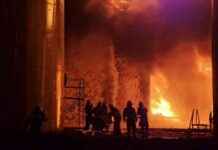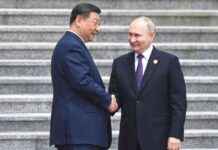In a recent report by the Institute for Strategic Studies (IISS), shocking revelations emerged regarding Russia’s staggering loss of armored vehicles in 2024. According to the report, Russian forces lost a staggering 5,100 tanks and armored vehicles, including 1,400 main battle tanks and 3,700 infantry fighting vehicles and armored personnel carriers. This marked a drastic increase from the 3,000 losses reported in the previous year, indicating a concerning trend in Russia’s military capabilities.
The alarming statistics shed light on the escalating conflict in Ukraine, where Russian forces have been engaged in ground assaults on various fronts. However, what is particularly surprising is the shift in tactics observed among Russian forces. Instead of relying solely on traditional armored vehicles for logistics and assaults, Russian troops have increasingly turned to unconventional means such as civilian cars, scooters, motorcycles, and even pack animals. This adaptation speaks volumes about the evolving nature of modern warfare and the challenges faced by conventional military strategies.
The Ukrainian General Staff provided even higher estimates of the losses, reporting over 3,000 tanks and a staggering 9,000 armored vehicles either damaged or destroyed in 2024. While IISS estimates likely account for completely destroyed vehicles, the sheer scale of the losses underscores the intensity of the conflict and its devastating impact on both sides.
One of the key findings in the report highlighted Russia’s production and replacement efforts in response to the significant losses. IISS estimated that Russia managed to produce and refurbish over 1,500 tanks and 2,800 infantry fighting vehicles and armored personnel carriers in 2024. This allowed Russia to replace all tank losses and three-quarters of the losses in armored vehicles. However, experts have raised concerns about the sustainability of this approach, as the remaining Soviet-era equipment stocks show signs of significant deterioration.
Major Viktor Trehubov, a spokesperson for the Khortytsia Group of Forces, emphasized the impact of Ukrainian drone strikes on Russian forces, forcing them to reduce their armored vehicle usage along the frontline. Trehubov also highlighted ammunition supply issues faced by Russian forces in certain areas following Ukrainian strikes on ammunition depots. These challenges further compound the logistical and operational difficulties faced by Russian troops on the ground.
Looking ahead, the report raises questions about the long-term viability of Russia’s military capabilities. With ongoing equipment shortages and the depletion of Soviet-era matériel, Russia may struggle to properly equip its forces in the future. This dilemma is exacerbated by the expansion of military divisions and the scarcity of spare parts, which pose significant challenges to the refurbishment efforts.
As the conflict in Ukraine continues to unfold, it remains to be seen how Russia will navigate the escalating losses and adapt its tactics to address the mounting challenges on the ground. The evolving dynamics of modern warfare highlight the importance of strategic foresight and adaptability in the face of ever-changing threats and operational environments.

















